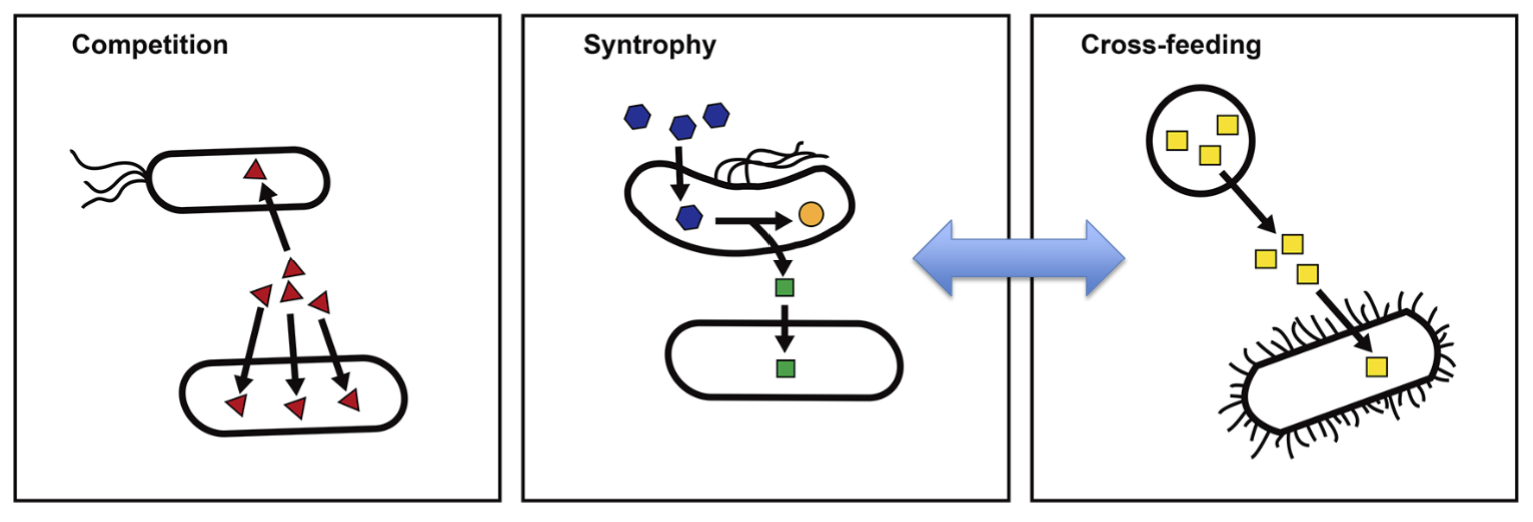Lecture 13:
The Role of Cross-Feeding in Microbial Resource Management
Microbial communities are complex networks of organisms that rely heavily on interactions for their stability and functionality. One of the pivotal interactions within microbial ecosystems is cross-feeding, where metabolic byproducts from one microorganism serve as nutrients for another. This document synthesizes multiple perspectives on microbial cross-feeding to provide a comprehensive understanding of its significance, mechanisms, and implications.
Assemblage of microbial communities
Deterministic and stochastic processes shape microbiome assembly.
Microbial community members can be introduced through genetic diversity and the movement of organisms (dispersal). The number of these members is influenced by natural selection, random fluctuations (drift), and ongoing dispersal. These factors exist along a spectrum, with some being stochastic (random) and others deterministic (based on specific factors).

Introduction to Microbial Cross-Feeding
Definition
Metabolic Cross-Feeding: An interaction between microorganisms where molecules resulting from the metabolism of one strain (producer) are further metabolized by another (receiver or beneficiary).
Importance
Cross-feeding interactions are crucial for the stability and function of microbial communities. They facilitate the sharing of essential small molecules synthesized by a specific subset of the population, contributing to the overall diversity, function, stability and health of the ecosystem.
Many microbes that inhabit the GI have growth requirements that are either absent or limiting in the diet.
Mechanisms of Cross-Feeding
Metabolite Transfer
Mechanisms: Nutritional interactions among microbes often involve the transfer of metabolites, which can occur through various mechanisms such as direct contact or the release of metabolites into the environment.
Examples
Interspecies Hydrogen Transfer: Certain interactions, like syntrophic associations between hydrogen-producing and hydrogen-consuming bacteria, are critical for metabolic processes in anaerobic environments.
Butyrate Production: In the gastrointestinal tract, cross-feeding between Bifidobacterium and butyrate-producing bacteria plays a significant role in generating butyrate, a key molecule for gut health.
Identification and Analysis of Cross-Feeding Interactions
Experimental Approaches
Metabolite Exchange Score (MES): This score can be inferred from metagenome-informed metabolic models to compare interactions in healthy versus diseased states, assisting in identifying critical species and metabolites.
Coculture experiments: involve growing two different types of bacteria together to see how they interact, especially in terms of cross-feeding. For example, when Bifidobacterium longum is grown with Megasphaera indica, Bifidobacterium helps produce butyrate by using lactate. This shows how various bacteria can work together and benefit from each other during their growth.
Bioinformatics and Modeling
Flux-Balance Analysis: This approach examines many different groups of microbial species to predict which combinations will grow best and to explain how they share nutrients with each other.
Ecological and Health Implications
Microbiome Stability and Diversity
Cross-feeding is essential for maintaining the stability and function of microbial communities in various ecosystems, including soil and the human gut. These interactions contribute to energy conservation and microbial growth yield in anaerobic environments.
Disease Associations
Crohn’s Disease: Specific alterations in cross-feeding interactions, such as a shift in hydrogen sulfide production-consumption equilibrium, can be linked with conditions like Crohn’s disease. Understanding these changes can provide insights into disease mechanisms and potential therapeutic targets.
Species-Specific Interactions: Loss of microbial cross-feeding interactions can contribute to disease-specific microbiome imbalances. Identifying and restoring these interactions are critical for developing microbiome-based therapies.
Evolution of Cooperative Cross-Feeding
Evolutionary Models
Hypothetical evolutionary models suggest that microbial strains may lose costly functions to improve growth efficiency, leading to more efficient cross-feeding networks.
Genetic Adaptations
Studies on microbial genetics reveal distinct gene clusters responsible for substrate utilization, indicating evolutionary adaptations that support cross-feeding mechanisms in diverse environments.
Conclusion
Microbial cross-feeding plays a vital role in the resilience and functionality of microbial ecosystems. Understanding the mechanisms and implications of these interactions offers valuable insights into microbial ecology, evolution, and potential applications in health and disease management. By harnessing the power of microbial cross-feeding, it is possible to develop innovative strategies for microbiome-based therapies and ecosystem management.